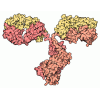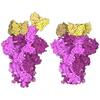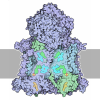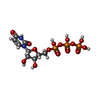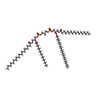[English] 日本語
 Yorodumi
Yorodumi- PDB-9fzq: Proton conductance by human uncoupling protein 1 is inhibited by ... -
+ Open data
Open data
- Basic information
Basic information
| Entry | Database: PDB / ID: 9fzq | ||||||||||||||||||||||||
|---|---|---|---|---|---|---|---|---|---|---|---|---|---|---|---|---|---|---|---|---|---|---|---|---|---|
| Title | Proton conductance by human uncoupling protein 1 is inhibited by both purine and pyrimidine nucleotides | ||||||||||||||||||||||||
 Components Components |
| ||||||||||||||||||||||||
 Keywords Keywords | TRANSPORT PROTEIN | ||||||||||||||||||||||||
| Function / homology |  Function and homology information Function and homology informationpurine ribonucleotide binding / cellular response to dehydroepiandrosterone / Mitochondrial Uncoupling / The fatty acid cycling model / oxidative phosphorylation uncoupler activity / mitochondrial transmembrane transport / adaptive thermogenesis / cardiolipin binding / cellular response to fatty acid / regulation of reactive oxygen species biosynthetic process ...purine ribonucleotide binding / cellular response to dehydroepiandrosterone / Mitochondrial Uncoupling / The fatty acid cycling model / oxidative phosphorylation uncoupler activity / mitochondrial transmembrane transport / adaptive thermogenesis / cardiolipin binding / cellular response to fatty acid / regulation of reactive oxygen species biosynthetic process / long-chain fatty acid binding / response to temperature stimulus / cellular response to cold / diet induced thermogenesis / proton transmembrane transporter activity / transmembrane transporter activity / brown fat cell differentiation / Transcriptional regulation of brown and beige adipocyte differentiation by EBF2 / cellular response to hormone stimulus / proton transmembrane transport / response to cold / cellular response to reactive oxygen species / response to nutrient levels / GDP binding / positive regulation of cold-induced thermogenesis / mitochondrial inner membrane / regulation of transcription by RNA polymerase II / GTP binding / mitochondrion Similarity search - Function | ||||||||||||||||||||||||
| Biological species |  Homo sapiens (human) Homo sapiens (human) | ||||||||||||||||||||||||
| Method | ELECTRON MICROSCOPY / single particle reconstruction / cryo EM / Resolution: 3.03 Å | ||||||||||||||||||||||||
 Authors Authors | Jones, S.A. / Sowton, A.P. / Lacabanne, D. / King, M.S. / Palmer, S.M. / Zogg, T. / Pardon, E. / Steyaert, J. / Ruprecht, J.J. / Kunji, E.R.S. | ||||||||||||||||||||||||
| Funding support |  United Kingdom, European Union, United Kingdom, European Union,  Belgium, 3items Belgium, 3items
| ||||||||||||||||||||||||
 Citation Citation |  Journal: EMBO J / Year: 2025 Journal: EMBO J / Year: 2025Title: Proton conductance by human uncoupling protein 1 is inhibited by purine and pyrimidine nucleotides. Authors: Scott A Jones / Alice P Sowton / Denis Lacabanne / Martin S King / Shane M Palmer / Thomas Zögg / Els Pardon / Jan Steyaert / Jonathan J Ruprecht / Edmund R S Kunji /   Abstract: Uncoupling protein 1 (UCP1, SLC25A7) is responsible for the thermogenic properties of brown adipose tissue. Upon fatty acid activation, UCP1 facilitates proton leakage, dissipating the mitochondrial ...Uncoupling protein 1 (UCP1, SLC25A7) is responsible for the thermogenic properties of brown adipose tissue. Upon fatty acid activation, UCP1 facilitates proton leakage, dissipating the mitochondrial proton motive force to release energy as heat. Purine nucleotides are considered to be the only inhibitors of UCP1 activity, binding to its central cavity to lock UCP1 in a proton-impermeable conformation. Here we show that pyrimidine nucleotides can also bind and inhibit its proton-conducting activity. All nucleotides bound in a pH-dependent manner, with the highest binding affinity observed for ATP, followed by dTTP, UTP, GTP and CTP. We also determined the structural basis of UTP binding to UCP1, showing that binding of purine and pyrimidine nucleotides follows the same molecular principles. We find that the closely related mitochondrial dicarboxylate carrier (SLC25A10) and oxoglutarate carrier (SLC25A11) have many cavity residues in common, but do not bind nucleotides. Thus, while UCP1 has evolved from dicarboxylate carriers, no selection for nucleobase specificity has occurred, highlighting the importance of the pH-dependent nucleotide binding mechanism mediated via the phosphate moieties. | ||||||||||||||||||||||||
| History |
|
- Structure visualization
Structure visualization
| Structure viewer | Molecule:  Molmil Molmil Jmol/JSmol Jmol/JSmol |
|---|
- Downloads & links
Downloads & links
- Download
Download
| PDBx/mmCIF format |  9fzq.cif.gz 9fzq.cif.gz | 122.8 KB | Display |  PDBx/mmCIF format PDBx/mmCIF format |
|---|---|---|---|---|
| PDB format |  pdb9fzq.ent.gz pdb9fzq.ent.gz | 87 KB | Display |  PDB format PDB format |
| PDBx/mmJSON format |  9fzq.json.gz 9fzq.json.gz | Tree view |  PDBx/mmJSON format PDBx/mmJSON format | |
| Others |  Other downloads Other downloads |
-Validation report
| Arichive directory |  https://data.pdbj.org/pub/pdb/validation_reports/fz/9fzq https://data.pdbj.org/pub/pdb/validation_reports/fz/9fzq ftp://data.pdbj.org/pub/pdb/validation_reports/fz/9fzq ftp://data.pdbj.org/pub/pdb/validation_reports/fz/9fzq | HTTPS FTP |
|---|
-Related structure data
| Related structure data |  50894MC M: map data used to model this data C: citing same article ( |
|---|---|
| Similar structure data | Similarity search - Function & homology  F&H Search F&H Search |
- Links
Links
- Assembly
Assembly
| Deposited unit | 
|
|---|---|
| 1 |
|
- Components
Components
| #1: Protein | Mass: 33339.629 Da / Num. of mol.: 1 Source method: isolated from a genetically manipulated source Source: (gene. exp.)  Homo sapiens (human) / Gene: UCP1, SLC25A7, UCP / Production host: Homo sapiens (human) / Gene: UCP1, SLC25A7, UCP / Production host:  | ||||
|---|---|---|---|---|---|
| #2: Antibody | Mass: 13423.773 Da / Num. of mol.: 1 Source method: isolated from a genetically manipulated source Source: (gene. exp.)   | ||||
| #3: Antibody | Mass: 14022.680 Da / Num. of mol.: 1 Source method: isolated from a genetically manipulated source Source: (gene. exp.)   | ||||
| #4: Chemical | ChemComp-UTP / | ||||
| #5: Chemical | | Has ligand of interest | Y | Has protein modification | Y | |
-Experimental details
-Experiment
| Experiment | Method: ELECTRON MICROSCOPY |
|---|---|
| EM experiment | Aggregation state: PARTICLE / 3D reconstruction method: single particle reconstruction |
- Sample preparation
Sample preparation
| Component | Name: UCP1 bound to UTP and in complex with two Pro-macrobodies Type: COMPLEX / Entity ID: #1-#3 / Source: RECOMBINANT | ||||||||||||||||||||||||||||||||
|---|---|---|---|---|---|---|---|---|---|---|---|---|---|---|---|---|---|---|---|---|---|---|---|---|---|---|---|---|---|---|---|---|---|
| Molecular weight | Experimental value: NO | ||||||||||||||||||||||||||||||||
| Source (natural) | Organism:  Homo sapiens (human) Homo sapiens (human) | ||||||||||||||||||||||||||||||||
| Source (recombinant) | Organism:  | ||||||||||||||||||||||||||||||||
| Buffer solution | pH: 6 | ||||||||||||||||||||||||||||||||
| Buffer component |
| ||||||||||||||||||||||||||||||||
| Specimen | Conc.: 3 mg/ml / Embedding applied: NO / Shadowing applied: NO / Staining applied: NO / Vitrification applied: YES | ||||||||||||||||||||||||||||||||
| Specimen support | Grid material: COPPER / Grid mesh size: 300 divisions/in. / Grid type: Quantifoil R1.2/1.3 | ||||||||||||||||||||||||||||||||
| Vitrification | Instrument: FEI VITROBOT MARK IV / Cryogen name: ETHANE / Humidity: 95 % / Chamber temperature: 277 K |
- Electron microscopy imaging
Electron microscopy imaging
| Experimental equipment |  Model: Titan Krios / Image courtesy: FEI Company |
|---|---|
| Microscopy | Model: FEI TITAN KRIOS |
| Electron gun | Electron source:  FIELD EMISSION GUN / Accelerating voltage: 300 kV / Illumination mode: FLOOD BEAM FIELD EMISSION GUN / Accelerating voltage: 300 kV / Illumination mode: FLOOD BEAM |
| Electron lens | Mode: BRIGHT FIELD / Nominal defocus max: 1800 nm / Nominal defocus min: 800 nm / Cs: 2.7 mm / C2 aperture diameter: 70 µm |
| Image recording | Electron dose: 50 e/Å2 / Film or detector model: GATAN K3 (6k x 4k) |
- Processing
Processing
| EM software | Name: PHENIX / Category: model refinement | ||||||||||||||||||||||||
|---|---|---|---|---|---|---|---|---|---|---|---|---|---|---|---|---|---|---|---|---|---|---|---|---|---|
| CTF correction | Type: PHASE FLIPPING AND AMPLITUDE CORRECTION | ||||||||||||||||||||||||
| 3D reconstruction | Resolution: 3.03 Å / Resolution method: FSC 0.143 CUT-OFF / Num. of particles: 705820 / Symmetry type: POINT | ||||||||||||||||||||||||
| Refine LS restraints |
|
 Movie
Movie Controller
Controller


 PDBj
PDBj